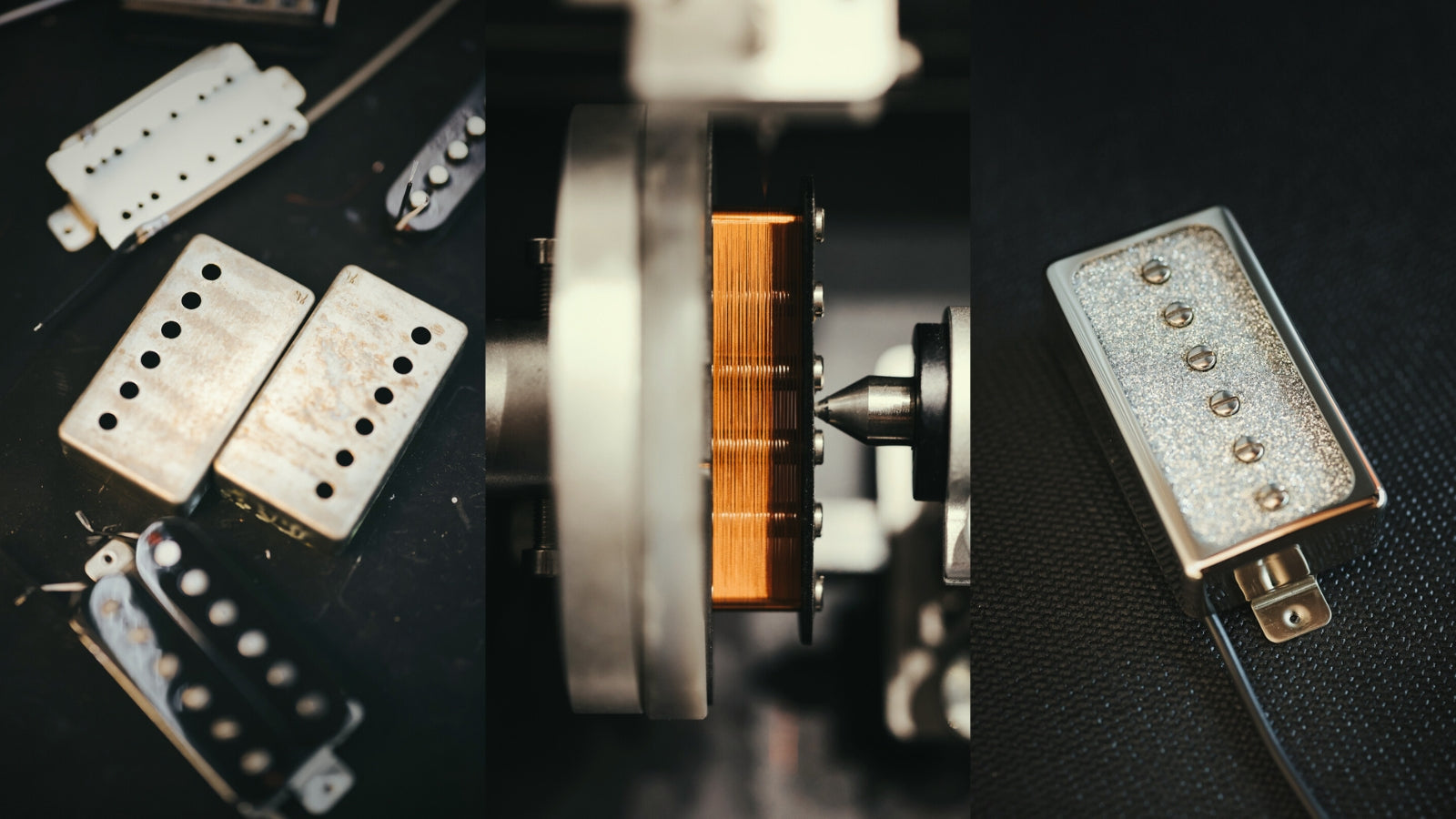
Which Lambertones Pickup is Right for Me?
Choosing the right guitar pickups isn’t just about choosing specs, it’s a balance of knowing what’s possible, leaning into your strengths as a player, and crafting your sound. Guitar tone is personal! Yes, we are inspired by others, and that’s a good thing. But at the end of the day, after the gig is done and the show is on the road, we want to bring a unique voice to the world. Choosing the correct guitar pickups is a critical step to the foundation of your tone, so that’s why we’ve put together a guide for you to help identify which Lambertones pickup is right for you. Whether you're playing glassy cleans, gritty blues, ambient worship, or down-tuned high output modern metal, there’s a Lambertones pickup that’s tuned for your guitar. Lets dive in!

Which Lambertones Pickup is Right for Me?
In this post, you’ll get a clear breakdown of every Lambertones pickup model, who they are designed for, what they sound like, and how they behave in the context of your rig. You'll also learn how to match your style, guitar type, and gain preferences to the right pickup.
I will walk you through all of our options so you can make an informed decision and avoid as much tone regret as possible. If you want to read more about the fundamentals of guitar tone, you can check out another blog post on how to get a good guitar tone.

How To Choose Guitar Pickups From Lambertones
There are several variables to consider when choosing the right guitar pickup or pickup set. Let's cover a few of the most important areas to have some knowledge on before you put your hard-earned money into new tones.
New pups, they don’t fit!?
A critical element for pickup selection is will they fit in my guitar?! We’ve had some pretty awkward conversations with customers who placed an order for custom pickups, only to find out they didn’t have the knowledge to understand that humbuckers don’t natively fit in a Fender Telecaster. Luckily, we have an incredible customer service team here at Lambertones, and you can text us a picture of your guitar and we’ll help you identify what is possible for your situation.
If you’re upgrading a guitar you already have possession of, for this example we’ll be referencing a 1998 MIM Fender Stratocaster©, it’s pretty simple to follow these steps:
Identify the pickup size currently installed.
Start with the bridge position and move forward (bridge, then middle, then neck).
Why size? We’ll discuss that a little later in this post, but for now lets identify if the pickup is one of the most common shapes: humbucker, tele bridge single coil, strat-sized single coil, wide-range humbucker, vintage-sized Filter’tron, etc. Once we know what size of pickup we have in the position, we can know what kinds of pickups we have to choose from to install! In our example model, the current pickups installed are strat single coil-sized pickups in the bridge, middle, and neck position.
Determine if there are alternative options available.
Once we know what size is currently installed, we can determine if there is any room for a pickup configuration swap. I.e. can I put a humbucker in the single coil bridge position of a strat? Not every guitar supports a diversity of pickup sizes; PRS guitars generally route the pickup pockets very specifically, as do most boutique and high-end guitar builders where the pickups are mounted directly to the wood without the use of a pickguard.
In our scenario with the ‘98 strat, my single coils are pickguard mounted, and I want to know if I can put a humbucker in the bridge. I want a fuller sound with more mids for my lead tone, and the Grinder humbucker by Lambertones sounds perfect, so lets find out if it’s a possibility. The best way to know for sure is to take the screws off of the pickguard, lift it up, and notice if the routing pocket(s) are large enough to fit a pickup that is bigger than the currently installed one. In our scenario, we have a “swimming pool” route, which is much larger than the stock strat-sized single coil, so our guitar can fit a humbucker in the bridge position, but our neck and middle routed pockets will only fit the current pickup size.

Choose from available options for its sonic characteristics.
Now that we know the pickup configuration is possible. What style of pickups do we want for our tone? We wrote another post you can reference that talks about the best guitar tones here, and since this is a completely subjective journey, I’m going to share with you my tone build in the hope that explaining that will help you identify exactly what you want for your guitar.
I want a lower output style pickup set, with tons of headroom for punchy cleans, since the strat position 4 is my favorite sound. That makes it an easy choice for the Lambertones Triple Shot neck and middle, which are scooped and have a ton of clarity on tap to let my finger dynamics impact how much breakup there is, but since I now know that I can put a humbucker in the bridge position (with a modified pickguard - lets not forget that detail, since a humbucker will not fit in the strat-sized bridge position), I need to decide what kind of lead tone I want. I’ve had a Crema in a strat before and it was awesome, but found that I was almost always using my first gain stage to get the baseline “clean tone” that I wanted. So for our example I’m going to select the Grinder humbucker, which has slightly more mids and compression than the Crema, ready to push that edge of breakup at any moment and still enough clarity to hear every note without mud.
This exercise of identifying the current configuration, noting if there’s room for alternatives, and then understanding the desired end result is in our opinion, the most efficient way to discovering which Lambertones pickup is right for you, or from any other pickup manufacturer out there.

What Are The Different Types Of Lambertones Pickups
We have several pickup types, configurations, and model variations of pickups available in our current line. Let’s learn about what they are and what kind of tones they were designed to produce to help you identify if a specific Lambertones pickups model is right for you.
But first, I want to touch on the topic of pickup size like I mentioned above. The reason size/shape is important to understand is that you might have more options than you realize. For example, we have a pickup model call “the Ristretto”. It’s a P90 style pickup, but you can get it in a soapbar style mount or a Jazzmaster-style mount. Very different dimensions, but it’s the same pickup model. Another example would be the ‘98 strat we discussed above. It had a strat-sized singled coil bridge pickup that we were able to swap out for a full-sized humbucker, but that required a pickguard change. If I wanted a different tone, but didn’t want to change the pickguard, I could look for another strat-sized pickup, say the DiMarzio Area 61 bridge pickup, and even though it is a “stacked single coil” (humbucker), its overall size is the same as the stock one, and would be a drop-in replacement.
Lets break this down by style, and we’ll discuss how each of Lambertones pickups can be utilized:

Humbuckers: Crema, Grinder, Red Eye, and Lamber’Tron
Size: Full-sized humbucker
Characteristics: Warm, rich, and dynamically responsive. The Crema is a very low-output humbucker that balances vintage clarity with modern bloom. Designed for expressive players who want definition with touch sensitivity, utilizing lower wattage amplifiers or digital modelers.
Best for: Jazz, worship, blues, and expressive clean-to-mid gain tones.
Pros: Balanced EQ, massive dynamic range, very note articulate.
Cons: Not ideal for ultra-high gain or drop-tuned styles. Will require multiple gain stages.
Size: Full-sized humbucker
Characteristics: Low-medium output, beautiful compression and mid range, with a tight low end. The Grinder is a modern player’s humbucker designed for edge, punch, and clarity under gain.
Best for: Rock, pop, worship, and players who want their amp to cut through any vocal or keys heavy mix.
Pros: Cuts through the mix, tight low end, coil-splitting friendly.
Cons: Feels like a light tube screamer is on all the time, but that’s not necessarily a bad thing.
Size: Full-sized humbucker
Characteristics: Medium output, massive mid range, still touch sensitive. The Red Eye is a driving humbucker designed for lead tone all day long, but cleans up beautifully if you ride the volume knob.
Best for: Rock, punk, metal, and players who want their amp to scream.
Pros: Beautiful gain bloom, touch sensitive breakup, full-send solo glory.
Cons: Not as “airy” as lower output models. Not ideal to be paired with single coils in a HSS configuration - too aggressive.
Size: Vintage Filter’tron-sized humbucker
Characteristics: Crisp, mids-focused, with a huge dynamic range. The Lamber’Tron is a low-output Filter’tron© style humbucker build with vintage sized magnets and custom mounting plates for multiple Gretsch-style drop-in replacement configurations. It balances clarity with lush upper mids for that tron sound without being nasily or muffled. Designed for guitar players looking for more clarity and articulation from their Gretsch-style guitars already loaded with vintage-sized Filter’tron© pickups.
Best for: Jazz, worship, blues, and expressive clean-to-mid gain tones.
Pros: Balanced EQ, massive dynamic range, very note articulate.
Cons: Not ideal for ultra-high gain or drop-tuned styles. Will require multiple gain stages. Fits in standard full-sized humbucker pickguard mounts or mounting rings, but will have gaps around the edges.
Single Coils: Blondie, Triple Shot, Ristretto, V90
Size: Telecaster-sized single coil set
Characteristics: Punchy, rich, and smooth breakup. A take on vintage ‘50s-era single coils with a modern punch, the Blondie set delivers chime, sparkle, and beautiful punch with a tighter bass response than typical vintage pickups. Features a hum-canceling middle position and can be used with a 4-way control plate or even an added middle pickup for the “Nashville” configuration.
Best for: Country, blues, classic rock, and ambient tones.
Pros: Bright and clear, low noise for a true single coil, touch sensitive breakup.
Cons: Not suited for high-gain, still has single-coil hum.
Size: Stratocaser-sized single coil
Characteristics: Based on John Mayer's favorite 1964 vintage Strat, but with enhanced clarity and consistency. Custom AlNiCo magnets with a unique wire and tension combination produce beautifully smooth and velvety lead lines. The Triple Shot features a slightly chunky and springy low-end, clean and crisp highs, massive quack (and hum-canceling) in positions 2/4, and all without a heavy and overbearing mid-range.
Best for: Funk, blues, classic rock, and reggae tones.
Pros: Clean and smooth, bell-like upper mids, dynamic breakup.
Cons: Not suited for high-gain, still has single-coil hum in position 1, 3, and 5.
Size: Soapbar or Jazzmaster-sized single coil
Characteristics: A no-compromise P90 pickup designed to fix what players hate while preserving what they love. Tighter bass, smoother highs, and balanced output. The Ristretto is a seemingly measurable “low-output” pickup, much less a P90, but with the dynamics, concentration, and balance of some of the best single-coil tones we have ever heard. Think HUGE strat neck pickup. Hum-canceling middle position.
Best for: Pop, rock, worship, and blues tones.
Pros: Punchy and clear, dig in for grit or back off for ambient.
Cons: Low end starts to lose clarity in high-gain situations, still has single-coil hum in position 1 and 3.
Size: Humbucker-sized P90 single coil
Characteristics: Medium output, featuring a prominent mid range with extreme touch sensitiity. The V90 is a mini P90 pickup that will snarl if you dig in and compress the signal, but will bloom to perfection with dynamic finger picking.
Best for: Rock, funk, and ambient worship tones.
Pros: Dynamic touch sensitive breakup, never too bright or dark.
Cons: Has single-coil hum, only fits in full-sized humbucker pickguard mounts or mounting rings.
Every guitarist’s tone journey is different, but it always starts with the right building blocks. Whether you're going after vintage with a twist, or utilizing multiple gain stages and delay banks, choosing the right pickup to complement your style and rig is essential. With Lambertones, you’re not just buying a pickup to make noise, you’re investing in your sound. See this post on How to Test A Guitar Pickup.
Still not sure where to start? Reach out to us here, and we’ll help you dial in the perfect match for your guitar and rig.



Leave a comment
This site is protected by hCaptcha and the hCaptcha Privacy Policy and Terms of Service apply.